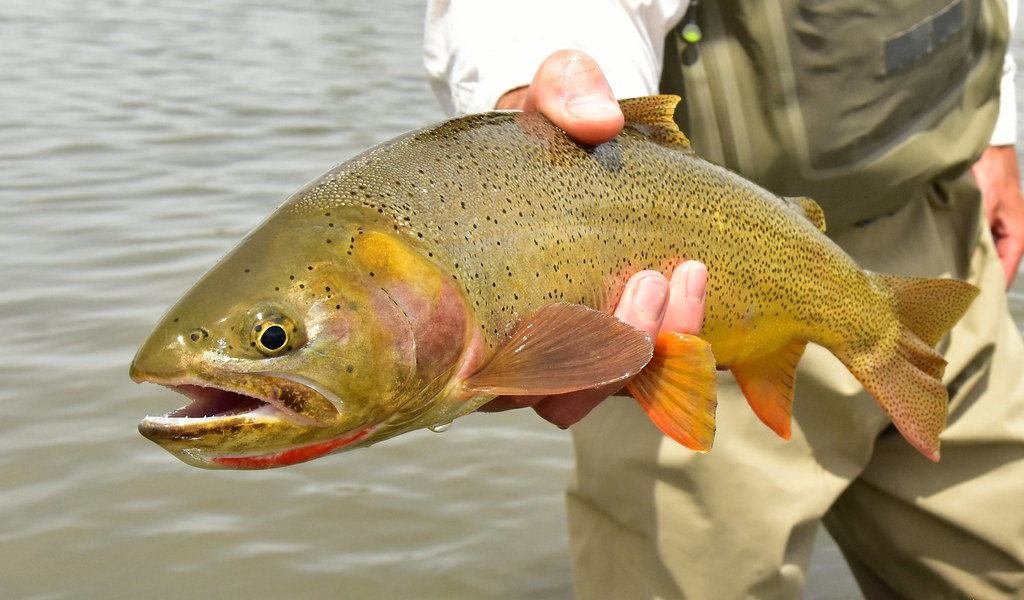Introduction to Cutthroat Trout
Cutthroat trout represent some of the most beautiful fish and rewarding angling pursuits found anywhere. Ranging in color from bright golden yellow to fiery orange and red tones, cutthroat trout originally evolved as native fish across the coldest headwaters of western North America. Anglers treasure opportunities to match wits with these wild trout on small creeks and alpine lakes. Ongoing conservation aims to protect this iconic species.
Physical Characteristics Of Cutthroat Trout
Cutthroat trout feature pale yellow to orange bodies with striking red, pink, or orange slash marks under their lower jaws that give them their name. Their spots vary from small spotted Coastal cutthroat to larger spots on Westslope and Yellowstone cutthroat. Most reach 6-18 inches, but some lake-dwelling cutthroat grow larger. Their colors and patterns dazzle anglers.
Distinctive Markings
No two cutthroat trout feature the exact same spot and slash mark patterns, making each fish unique. Their cryptic colors and patterns camouflage cutthroat in home rivers ranging from golden gravel streams to darker volcanic cobble. Spawning adults intensify in their vivid breeding colors.
Range and Habitat of Cutthroat Trout
These trout evolved as native fish across western North America with distinct subspecies associated with major river drainages like the Yellowstone, Snake, Green, Colorado and coastal regions. They thrive in cold, clean streams, rivers, ponds, and alpine lakes with gravel shallows and pools. Protecting remaining genetically pure stocks represents a major initiative.
Diet and Prey
From larval insects to adult grasshoppers, crickets, smaller fish and more, cutthroat dine on diverse fare based on seasonal availability. In headwaters they gorge on terrestrial insects while larger fish eat other fish. Identifying key food sources helps anglers select the best flies and lures.
Life Stages and Behavior of Cutthroat Trout
Most cutthroat spawn by age 2-4 in small tributary creeks and rivers. Adults migrate upstream in spring to spawn in shallow gravel beds along riffle margins. Some cutthroat live entire lives in tiny headwaters while others migrate to lakes or mainstem rivers. Understanding these movement patterns helps locate fish during different seasons.
Willingness to Bite
Eager to pack on weight after spawning rigors, cutthroat actively chase down prey and will strike attractor dry flies, nymphs, streamers and small lures with intensity. Their aggression makes cutthroat a perfect species for beginning anglers to hone skills.
Fishing for Cutthroat Trout
A simple attractor dry fly pattern drifted along current seams and bank edges will tempt cutthroat trout in small creeks. An Adams or Humpy dry fly twitched to imitate a struggling insect also triggers violent strikes. In lakes, retrieved wet flies, nymphs and streamers work well. Light tackle like a 2-3 weight fly rod makes even smaller cutthroat a thrill.
Reading the Water
Locating current breaks, heads of pools, logjams, undercut banks and other structure provides prime spots to thoroughly fish various flies and lures. Following seasonal migrations allows targeting different segments of cutthroat populations at optimal times as they move into tributaries, mainstem rivers or lakes.
Conservation Status
Habitat degradation from development, water diversion, and competition from introduced trout have impacted many cutthroat populations, with two subspecies already extinct. Protecting remaining genetically pure cutthroat represents a major initiative through restoring habitats, installing barriers to favor natives, and tailoring angling practices to be sustainable.
Unique Species Complex
The various subspecies of cutthroat represent one of the most diverse species complexes, but also one of the most threatened. Supporting conservation groups like Trout Unlimited aids cutthroat recovery through volunteer projects aimed at improving habitat.
Importance
Beyond angling appeal, cutthroat trout provide an important part of western aquatic ecosystems through their role as predators and prey. They represent indicators of healthy cold, clean headwaters critical to entire watersheds. The stunning beauty of cutthroat continues inspiring anglers to protect remaining populations so future generations can enjoy their wild origins.
Cultural Significance
Native American tribes like the Blackfeet in Montana sustainably harvested cutthroat trout for subsistence over centuries. Their names reflect this cultural legacy. Restoring robust populations honors those traditions. Catching vibrant cutthroat trout lights a passion for fishing in many anglers.
Interesting Facts About Cutthroat Trout
- The current world record cutthroat trout weighed 41 pounds and was caught in 1925 from Pyramid Lake, although fish over 10 pounds are rare.
- Unique lake-run cutthroat called “salmon” migrate into huge lakes like Flathead Lake and Lake Tahoe to feed and grow huge. They spawn in tributaries.
- Selectively bred strains of cutthroat trout like the Colorado River “Snake River Cutt-Bow” hybrid offer trophy trout potential.
- No two cutthroat feature the exact same spot and slash mark patterns, making each fish distinct like a fingerprint. Their colors also intensify by season and spawning condition.
- During spring spawning runs, vivid colors help cutthroat identify rivals and potential mates in rushing water when visibility is poor.
Responsible Angling
Using appropriate tackle to minimize fight times, reviving tired fish before release, avoiding spawning fish, and strictly following limits sustains fisheries. Anglers can volunteer to help restore degraded habitats. Reporting tagged fish provides biologists with data to guide management.
Conclusion
Protecting remaining genetically pure cutthroat trout populations represents a key initiative for anglers and biologists across western North America. Restoring degraded habitats and removing introduced species threats allows vibrant cutthroat fisheries to thrive once again. The future remains hopeful for these iconic fish.
